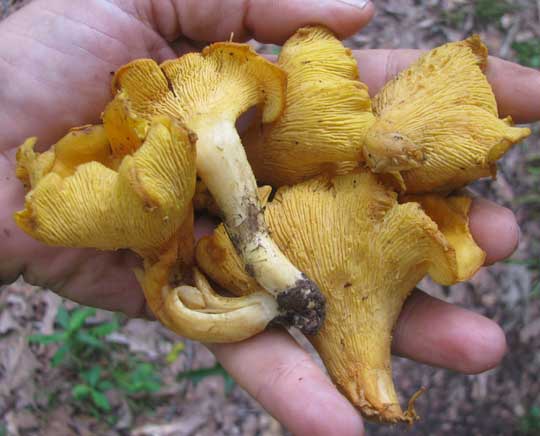Excerpts from Jim Conrad's
Naturalist Newsletter

from the May 20, 2012 Newsletter issued from the woods of the Loess Hill Region a few miles east of Natchez, Mississippi, USA
CHANTERELLES UP!
After a couple of rainy days last week mushrooms began popping up. One kind was especially welcome, the orange, funnel-shaped ones about 2½-inches high (7cm) shown above. Those are Chanterelles, CANTHARELLUS CIBARIUS. Well, actually the taxonomy of the chanterelle group is so complex and poorly understood that probably several unrecognized species are lumped under that name, but at the moment that's the best name to use.
Chanterelles are among the best known, most appreciated and often most common of edible mushrooms. They're widely distributed throughout much of the world's temperate zones. During my hermit days near here sometimes bathtubs of them could have been picked, though here so far this year they're a bit spotty. When I lived in Germany we called them Pfefferlings. The ones there were smaller but even tastier than ours. You can see a handful I collected this week below:

Notice the Chanterelle's general funnel shape and the shallow, orange gills that gradually diminish as they extend partway down the stem. These features are important because they distinguish Chanterelles from a slightly similar poisonous species, the Jack O'Lantern Mushroom, which is less funnel-shaped and whose stems are more distinct and with gills not descending them.
The best way to prepare Chanterelles is to lightly sauté them in butter, with a little salt and pepper. I didn't have those ingredients so I made a Chanterelle omelet which when eaten with a ripe tomato from the garden, slices of sweet onion and hot, moist cornbread was wonderful.
Of course, mushrooms are just the spore-producing reproductive structures of fungi whose "working bodies" actually are networks of threadlike hyphae occupying the soil and organic matter.
It happens that the hyphae of Chanterelles, as with many fungi, form symbiotic "mycorrhizal associations" on the roots of certain vascular plants. In these associations the fungus forms a hyphal sheath covering the plant's root tip, plus it forms a network of hyphae surrounding plant cells within the plant-root cortex. Outside the root, the hyphae grow into the soil and leaf litter forming extensive networks.
In these relationships, the fungus benefits by gaining access to the plant's carbohydrates, such as glucose and sucrose and, in return, the plant's roots gain increased ability to absorb water and mineral nutrients thanks to the greatly increased surface area provided by the fungus/root complex -- the "mycorrhizal association."